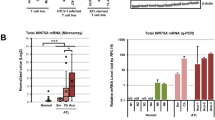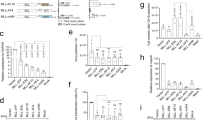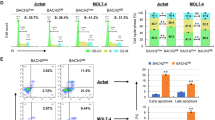Abstract
Human T-cell leukemia virus type 1 (HTLV-1) is the causative agent of adult T-cell leukemia (ATL). HTLV-1 bZIP factor (HBZ), the viral gene transcribed from the antisense strand, is consistently expressed in ATL cells and promotes their proliferation. In this study, we found that a Wnt pathway-related protein, disheveled-associating protein with a high frequency of leucine residues (DAPLE), interacts with both HTLV-1 Tax and HBZ. In the presence of DAPLE, Tax activated canonical Wnt signaling. Conversely, HBZ markedly suppressed canonical Wnt activation induced by either Tax/DAPLE or β-catenin. As a mechanism of HBZ-mediated Wnt suppression, we found that HBZ targets lymphoid enhancer-binding factor 1, one of the key transcription factors of the pathway, and impairs its DNA-binding ability. We also observed that the canonical Wnt pathway was not activated in HTLV-1-infected cells, whereas the representative of noncanonical Wnt ligand, Wnt5a, which antagonizes canonical Wnt signaling, was overexpressed. HBZ was able to induce Wnt5a transcription by enhancing its promoter activity through the TGF-β pathway. Importantly, knocking down of Wnt5a in ATL cells repressed cellular proliferation and migration. Our results implicate novel roles of HBZ in ATL leukemogenesis through dysregulation of both the canonical and noncanonical Wnt pathways.
This is a preview of subscription content, access via your institution
Access options
Subscribe to this journal
Receive 50 print issues and online access
$259.00 per year
only $5.18 per issue
Buy this article
- Purchase on Springer Link
- Instant access to full article PDF
Prices may be subject to local taxes which are calculated during checkout





Similar content being viewed by others
References
Poiesz BJ, Ruscetti FW, Gazdar AF, Bunn PA, Minna JD, Gallo RC . Detection and isolation of type C retrovirus particles from fresh and cultured lymphocytes of a patient with cutaneous T-cell lymphoma. Proc Natl Acad Sci USA 1980; 77: 7415–7419.
Hinuma Y, Nagata K, Hanaoka M, Nakai M, Matsumoto T, Kinoshita KI et al. Adult T-cell leukemia: antigen in an ATL cell line and detection of antibodies to the antigen in human sera. Proc Natl Acad Sci USA 1981; 78: 6476–6480.
Takatsuki K . Discovery of adult T-cell leukemia. Retrovirology 2005; 2: 16.
Gallo RC . The discovery of the first human retrovirus: HTLV-1 and HTLV-2. Retrovirology 2005; 2: 17.
Matsuoka M, Jeang KT . Human T-cell leukaemia virus type 1 (HTLV-1) infectivity and cellular transformation. Nat Rev Cancer 2007; 7: 270–280.
Grassmann R, Aboud M, Jeang KT . Molecular mechanisms of cellular transformation by HTLV-1 Tax. Oncogene 2005; 24: 5976–5985.
Franchini G, Fukumoto R, Fullen JR . T-cell control by human T-cell leukemia/lymphoma virus type 1. Int J Hematol 2003; 78: 280–296.
Satou Y, Yasunaga J, Yoshida M, Matsuoka M . HTLV-I basic leucine zipper factor gene mRNA supports proliferation of adult T cell leukemia cells. Proc Natl Acad Sci USA 2006; 103: 720–725.
Arnold J, Zimmerman B, Li M, Lairmore MD, Green PL . Human T-cell leukemia virus type-1 antisense-encoded gene, Hbz, promotes T-lymphocyte proliferation. Blood 2008; 112: 3788–3797.
Satou Y, Yasunaga J, Zhao T, Yoshida M, Miyazato P, Takai K et al. HTLV-1 bZIP factor induces T-cell lymphoma and systemic inflammation in vivo. PLoS Pathog 2011; 7: e1001274.
MacDonald BT, Tamai K, He X . Wnt/beta-catenin signaling: components, mechanisms, and diseases. Dev Cell 2009; 17: 9–26.
Staal FJ, Clevers HC . WNT signalling and haematopoiesis: a WNT-WNT situation. Nat Rev Immunol 2005; 5: 21–30.
Staal FJ, Luis TC, Tiemessen MM . WNT signalling in the immune system: WNT is spreading its wings. Nat Rev Immunol 2008; 8: 581–593.
McDonald SL, Silver A . The opposing roles of Wnt-5a in cancer. Br J Cancer 2009; 101: 209–214.
Cha MY, Kim CM, Park YM, Ryu WS . Hepatitis B virus X protein is essential for the activation of Wnt/beta-catenin signaling in hepatoma cells. Hepatology 2004; 39: 1683–1693.
Street A, Macdonald A, McCormick C, Harris M . Hepatitis C virus NS5A-mediated activation of phosphoinositide 3-kinase results in stabilization of cellular beta-catenin and stimulation of beta-catenin-responsive transcription. J Virol 2005; 79: 5006–5016.
Fujimuro M, Wu FY, ApRhys C, Kajumbula H, Young DB, Hayward GS et al. A novel viral mechanism for dysregulation of beta-catenin in Kaposi’s sarcoma-associated herpesvirus latency. Nat Med 2003; 9: 300–306.
Shackelford J, Maier C, Pagano JS . Epstein–Barr virus activates beta-catenin in type III latently infected B lymphocyte lines: association with deubiquitinating enzymes. Proc Natl Acad Sci USA 2003; 100: 15572–15576.
Uren A, Fallen S, Yuan H, Usubutun A, Kucukali T, Schlegel R et al. Activation of the canonical Wnt pathway during genital keratinocyte transformation: a model for cervical cancer progression. Cancer Res 2005; 65: 6199–6206.
Muller-Tidow C, Steffen B, Cauvet T, Tickenbrock L, Ji P, Diederichs S et al. Translocation products in acute myeloid leukemia activate the Wnt signaling pathway in hematopoietic cells. Mol Cell Biol 2004; 24: 2890–2904.
Lu D, Zhao Y, Tawatao R, Cottam HB, Sen M, Leoni LM et al. Activation of the Wnt signaling pathway in chronic lymphocytic leukemia. Proc Natl Acad Sci USA 2004; 101: 3118–3123.
McWhirter JR, Neuteboom ST, Wancewicz EV, Monia BP, Downing JR, Murre C . Oncogenic homeodomain transcription factor E2A-Pbx1 activates a novel WNT gene in pre-B acute lymphoblastoid leukemia. Proc Natl Acad Sci USA 1999; 96: 11464–11469.
Jamieson CH, Ailles LE, Dylla SJ, Muijtjens M, Jones C, Zehnder JL et al. Granulocyte-macrophage progenitors as candidate leukemic stem cells in blast-crisis CML. N Engl J Med 2004; 351: 657–667.
Hagiya K, Yasunaga J, Satou Y, Ohshima K, Matsuoka M . ATF3 an HTLV-1 bZip factor binding protein, promotes proliferation of adult T-cell leukemia cells. Retrovirology 2011; 8: 19.
Oshita A, Kishida S, Kobayashi H, Michiue T, Asahara T, Asashima M et al. Identification and characterization of a novel Dvl-binding protein that suppresses Wnt signalling pathway. Genes Cells 2003; 8: 1005–1017.
Zhao T, Yasunaga J, Satou Y, Nakao M, Takahashi M, Fujii M et al. Human T-cell leukemia virus type 1 bZIP factor selectively suppresses the classical pathway of NF-kappaB. Blood 2009; 113: 2755–2764.
Gaudray G, Gachon F, Basbous J, Biard-Piechaczyk M, Devaux C, Mesnard JM . The complementary strand of the human T-cell leukemia virus type 1 RNA genome encodes a bZIP transcription factor that down-regulates viral transcription. J Virol 2002; 76: 12813–12822.
Lemasson I, Lewis MR, Polakowski N, Hivin P, Cavanagh MH, Thebault S et al. Human T-cell leukemia virus type 1 (HTLV-1) bZIP protein interacts with the cellular transcription factor CREB to inhibit HTLV-1 transcription. J Virol 2007; 81: 1543–1553.
Clerc I, Polakowski N, Andre-Arpin C, Cook P, Barbeau B, Mesnard JM et al. An interaction between the human T cell leukemia virus type 1 basic leucine zipper factor (HBZ) and the KIX domain of p300/CBP contributes to the down-regulation of tax-dependent viral transcription by HBZ. J Biol Chem 2008; 283: 23903–23913.
Yanagawa S, van Leeuwen F, Wodarz A, Klingensmith J, Nusse R . The dishevelled protein is modified by wingless signaling in Drosophila. Genes Dev 1995; 9: 1087–1097.
van de Wetering M, Oosterwegel M, Dooijes D, Clevers H . Identification and cloning of TCF-1, a T lymphocyte-specific transcription factor containing a sequence-specific HMG box. EMBO J 1991; 10: 123–132.
Travis A, Amsterdam A, Belanger C, Grosschedl R . LEF-1, a gene encoding a lymphoid-specific protein with an HMG domain, regulates T-cell receptor alpha enhancer function (corrected). Genes Dev 1991; 5: 880–894.
Groen RW, Oud ME, Schilder-Tol EJ, Overdijk MB, ten Berge D, Nusse R et al. Illegitimate WNT pathway activation by beta-catenin mutation or autocrine stimulation in T-cell malignancies. Cancer Res 2008; 68: 6969–6977.
Roarty K, Serra R . Wnt5a is required for proper mammary gland development and TGF-beta-mediated inhibition of ductal growth. Development 2007; 134: 3929–3939.
Katoh M . Transcriptional mechanisms of WNT5A based on NF-kappaB, Hedgehog, TGFbeta, and Notch signaling cascades. Int J Mol Med 2009; 23: 763–769.
Zhao T, Satou Y, Sugata K, Miyazato P, Green PL, Imamura T et al. HTLV-1 bZIP factor enhances TGF-beta signaling through p300 coactivator. Blood 2011; 118: 1865–1876.
Weeraratna AT, Jiang Y, Hostetter G, Rosenblatt K, Duray P, Bittner M et al. Wnt5a signaling directly affects cell motility and invasion of metastatic melanoma. Cancer Cell 2002; 1: 279–288.
Dissanayake SK, Wade M, Johnson CE, O’Connell MP, Leotlela PD, French AD et al. The Wnt5A/protein kinase C pathway mediates motility in melanoma cells via the inhibition of metastasis suppressors and initiation of an epithelial to mesenchymal transition. J Biol Chem 2007; 282: 17259–17271.
Driessens G, Zheng Y, Locke F, Cannon JL, Gounari F, Gajewski TF . Beta-catenin inhibits T cell activation by selective interference with linker for activation of T cells-phospholipase C-gamma1 phosphorylation. J Immunol 2011; 186: 784–790.
Badiglian Filho L, Oshima CT, De Oliveira Lima F, De Oliveira Costa H, De Sousa Damiao R, Gomes TS et al. Canonical and noncanonical Wnt pathway: a comparison among normal ovary, benign ovarian tumor and ovarian cancer. Oncol Rep 2009; 21: 313–320.
Kageshita T, Hamby CV, Ishihara T, Matsumoto K, Saida T, Ono T . Loss of beta-catenin expression associated with disease progression in malignant melanoma. Br J Dermatol 2001; 145: 210–216.
Bachmann IM, Straume O, Puntervoll HE, Kalvenes MB, Akslen LA . Importance of P-cadherin, beta-catenin, and Wnt5a/frizzled for progression of melanocytic tumors and prognosis in cutaneous melanoma. Clin Cancer Res 2005; 11: 8606–8614.
Da Forno PD, Pringle JH, Hutchinson P, Osborn J, Huang Q, Potter L et al. WNT5A expression increases during melanoma progression and correlates with outcome. Clin Cancer Res 2008; 14: 5825–5832.
Klemm F, Bleckmann A, Siam L, Chuang HN, Rietkotter E, Behme D et al. Beta-catenin-independent WNT signaling in basal-like breast cancer and brain metastasis. Carcinogenesis 2011; 32: 434–442.
Yamamoto H, Oue N, Sato A, Hasegawa Y, Matsubara A, Yasui W et al. Wnt5a signaling is involved in the aggressiveness of prostate cancer and expression of metalloproteinase. Oncogene 2010; 29: 2036–2046.
Sukarawan W, Simmons D, Suggs C, Long K, Wright JT . WNT5A expression in ameloblastoma and its roles in regulating enamel epithelium tumorigenic behaviors. Am J Pathol 2010; 176: 461–471.
Yamagishi M, Nakano K, Miyake A, Yamochi T, Kagami Y, Tsutsumi A et al. Polycomb-mediated loss of miR-31 activates NIK-dependent NF-kappaB pathway in adult T cell leukemia and other cancers. Cancer Cell 2012; 21: 121–135.
Peloponese JM, Yasunaga J, Kinjo T, Watashi K, Jeang KT . Peptidylproline cis-trans-isomerase Pin1 interacts with human T-cell leukemia virus type 1 tax and modulates its activation of NF-kappaB. J Virol 2009; 83: 3238–3248.
Zhi H, Yang L, Kuo YL, Ho YK, Shih HM, Giam CZ . NF-kappaB hyper-activation by HTLV-1 tax induces cellular senescence, but can be alleviated by the viral anti-sense protein HBZ. PLoS Pathog 2011; 7: e1002025.
Pise-Masison CA, Radonovich M, Dohoney K, Morris JC, O’Mahony D, Lee MJ et al. Gene expression profiling of ATL patients: compilation of disease-related genes and evidence for TCF4 involvement in BIRC5 gene expression and cell viability. Blood 2009; 113: 4016–4026.
Kuo YL, Giam CZ . Activation of the anaphase promoting complex by HTLV-1 tax leads to senescence. EMBO J 2006; 25: 1741–1752.
Hanon E, Hall S, Taylor GP, Saito M, Davis R, Tanaka Y et al. Abundant tax protein expression in CD4+ T cells infected with human T-cell lymphotropic virus type I (HTLV-I) is prevented by cytotoxic T lymphocytes. Blood 2000; 95: 1386–1392.
Saito M, Matsuzaki T, Satou Y, Yasunaga J, Saito K, Arimura K et al. In vivo expression of the HBZ gene of HTLV-1 correlates with proviral load, inflammatory markers and disease severity in HTLV-1 associated myelopathy/tropical spastic paraparesis (HAM/TSP). Retrovirology 2009; 6: 19.
Jho EH, Zhang T, Domon C, Joo CK, Freund JN, Costantini F . Wnt/beta-catenin/Tcf signaling induces the transcription of axin2, a negative regulator of the signaling pathway. Mol Cell Biol 2002; 22: 1172–1183.
Shibamoto S, Higano K, Takada R, Ito F, Takeichi M, Takada S . Cytoskeletal reorganization by soluble Wnt-3a protein signalling. Genes Cells 1998; 3: 659–670.
Lee JS, Ishimoto A, Yanagawa S . Characterization of mouse dishevelled (Dvl) proteins in Wnt/Wingless signaling pathway. J Biol Chem 1999; 274: 21464–21470.
Yanagawa S, Lee JS, Matsuda Y, Ishimoto A . Biochemical characterization of the Drosophila axin protein. FEBS Lett 2000; 474: 189–194.
Tezuka N, Brown AM, Yanagawa S . GRB10 binds to LRP6, the Wnt co-receptor and inhibits canonical Wnt signaling pathway. Biochem Biophys Res Commun 2007; 356: 648–654.
Watashi K, Khan M, Yedavalli VR, Yeung ML, Strebel K, Jeang KT . Human immunodeficiency virus type 1 replication and regulation of APOBEC3G by peptidyl prolyl isomerase Pin1. J Virol 2008; 82: 9928–9936.
Satou Y, Nosaka K, Koya Y, Yasunaga JI, Toyokuni S, Matsuoka M . Proteasome inhibitor, bortezomib, potently inhibits the growth of adult T-cell leukemia cells both in vivo and in vitro. Leukemia 2004; 18: 1357–1363.
Fan J, Kodama E, Koh Y, Nakao M, Matsuoka M . Halogenated thymidine analogues restore the expression of silenced genes without demethylation. Cancer Res 2005; 65: 6927–6933.
Acknowledgements
We thank H Miyoshi for providing lentiviral packaging vectors and L Kingsbury for proofreading of this manuscript. This work was supported by a Grant-in-aid for Scientific Research from the Ministry of Education, Science, Sports, and Culture of Japan to MM, and a grant from the Takeda Science Foundation to JY.
Author information
Authors and Affiliations
Corresponding author
Ethics declarations
Competing interests
The authors declare no conflict of interest.
Additional information
Supplementary Information accompanies the paper on the Oncogene website
Supplementary information
Rights and permissions
About this article
Cite this article
Ma, G., Yasunaga, J., Fan, J. et al. HTLV-1 bZIP factor dysregulates the Wnt pathways to support proliferation and migration of adult T-cell leukemia cells. Oncogene 32, 4222–4230 (2013). https://doi.org/10.1038/onc.2012.450
Received:
Revised:
Accepted:
Published:
Issue Date:
DOI: https://doi.org/10.1038/onc.2012.450
Keywords
This article is cited by
-
Designer nucleases to treat malignant cancers driven by viral oncogenes
Virology Journal (2021)
-
Overexpression of aberrant Wnt5a and its effect on acquisition of malignant phenotypes in adult T-cell leukemia/lymphoma (ATL) cells
Scientific Reports (2021)
-
Global expression of noncoding RNome reveals dysregulation of small RNAs in patients with HTLV-1–associated adult T-cell leukemia: a pilot study
Infectious Agents and Cancer (2021)
-
HTLV-1 bZIP factor: the key viral gene for pathogenesis
Retrovirology (2020)
-
Comparative virology of HTLV-1 and HTLV-2
Retrovirology (2019)



